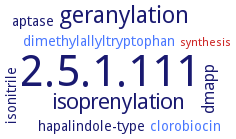2.5.1.111: 4-hydroxyphenylpyruvate 3-dimethylallyltransferase
This is an abbreviated version!
For detailed information about 4-hydroxyphenylpyruvate 3-dimethylallyltransferase, go to the full flat file.

Word Map on EC 2.5.1.111 
-
2.5.1.111
-
geranylation
-
isoprenylation
-
dmapp
-
dimethylallyltryptophan
-
clorobiocin
-
isonitrile
-
hapalindole-type
-
aptase
-
synthesis
- 2.5.1.111
-
geranylation
-
isoprenylation
-
dmapp
- dimethylallyltryptophan
- clorobiocin
-
isonitrile
-
hapalindole-type
-
aptase
- synthesis
Reaction
Synonyms
4HPP dimethylallyltransferase, apT, aromatic prenyltransferase, CloQ, FamD1, isoprenyl transferase, NovQ
ECTree
Advanced search results
General Information
General Information on EC 2.5.1.111 - 4-hydroxyphenylpyruvate 3-dimethylallyltransferase
Please wait a moment until all data is loaded. This message will disappear when all data is loaded.
malfunction
cloQ-defective mutant of the clorobiocin producer Streptomyces roseochromogenes, which is blocked in the biosynthesis of the prenylated 4-hydroxybenzoic acid moiety of clorobiocin produces three new antibiotics, vanillobiocin, isovanillobiocin and declovanillobiocin. The isolated compounds are similar to clorobiocin, but contain vanillic acid as the acyl component instead of the prenylated 4-hydroxybenzoic acid present in clorobiocin. Isovanillobiocin differs from vanillobiocin by the position of the pyrrole unit attached to the sugar moiety of the antibiotic. Declovanillobiocin lacks the chlorine atom at the aminocoumarin ring. All three compounds have lower antibiotic activity against Bacillus subtilis than clorobiocin
physiological function
involved in the synthesis of the prenylated hydroxybenzoate moiety of the antibiotic clorobiocin, specifically catalyzing the attachment of a dimethylallyl moiety to 4-hydroxyphenylpyruvate
physiological function
the enzyme is involved in the biosynthesis of the 4-hydroxy-3-dimethylallylphenylpyruvate moiety of the aminocoumarin antibiotic clorobiocin
physiological function
-
the enzyme is involved in the biosynthesis of the 4-hydroxy-3-dimethylallylphenylpyruvate moiety of the aminocoumarin antibiotic clorobiocin
-


 results (
results ( results (
results ( top
top






